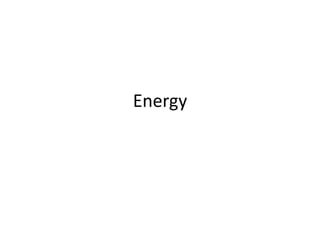
PEShare.co.uk Shared Resource
- 1. Energy
- 2. Adenosine Triphosphate 1 Adenosine Phosphate Phosphate Phosphate 2 Adenosine Phosphate Phosphate Phosphate ATPase 11 3 Adenosine Phosphate ENERGY Phosphate
- 3. • The energy released from the breakdown of ATP to ADP + P is converted to kinetic and heat energy. • The bond then needs to be re-built to be broken down again to create more energy. • There are four ways that this is done in the body: 1. ATP System 2. Phosphocreatine system 3. Lactic Acid System 4. Aerobic Energy System
- 4. Phosphocreatine System • Phosphocreatine is found in the sarcoplasm. • When the enzyme ‘creatine kinase’ is present: Phosphocreatine --------------> P + Creatine + Energy • For every molecule of PC broken down, 1 molecule of ATP is produced. • No fatiguing by-products are released • Occurs between approximately 3-10 seconds of exercise.
- 5. ATP production in the lactic acid system • Involves the partial breakdown of glucose. • The enzyme ‘Phosphofructokinase’ is released when levels of phosphocreatine drop, and begin to break down the glucose molecules. • These molecules break down into two pyruvic acid molecules. • When oxygen is not present, pyruvic acid is converted into lactic acid by the enzyme ‘lactate dehydrogenase’. • For every mole of glycogen broken down, 2 molecules of ATP are gained.
- 6. The Aerobic System NO PYRUVIC ACID LACTIC ACID OXYGEN H2O 2 ATP OXYGEN ELECTRON TRANSPORT CHAIN ACETYL-COENZYME A KREBS CITRIC ACID CYCLE 34 ATP = Pyruvate Dehydrogenase
- 7. The Aerobic System • If Oxygen is present then the pyruvic acid will convert into oxygen, and then into acetyl co-enzyme A and then (due to PDH) into citric acid until proceeding on to Krebes Cycle. • In the Krebes cycle, 2 molecules of ATP are created. • Then after entering the “electron transport chain” 34 molecules of ATP are created. Water is a by-product. • Takes place in the mitochondria.
- 8. The relationship of: intensity, hydrogen and oxygen More Muscle More ATP hydrogen is More oxygen Exercise More glucose contraction must be released in is required to becomes is broken requires more resynthesized the electron combine with more intense down ATP transport the hydrogen chain
- 9. Energy From Fats and Proteins FATS • Fat is stored in adipose tissue as triglycerides. • Requires more oxygen than the breakdown of glycogen. • The presence of lactic acid inhibits the fat breakdown. PROTEINS • Our bodies only rarely use proteins for ATP re-synthesis. • Only used when the body is in a state of exhaustion.
- 10. SUMMARY ATP-PC SYSTEM LACTIC ACID AEROBIC Site of reaction Sarcoplasm Sarcoplasm Sarcoplasm + Mitochondria Oxygen present Anaerobic Anaerobic Aerobic Fuel used Phosphocreatine Carbohydrates Carbohydrate and Fat Active enzyme Creatine Kinase Phosphofructokinase Phosphofructokinase + Lipase Enzyme activated by ATP increase Decrease in PC levels Decrease in insulin levels Relative speed Very fast Fast Slow By-products None Lactic Acid Carbon Dioxide and Water Effects of by-products None Inhibits enzyme None as easily expelled from body Energy Yield 1 2 38 Threshold 3-10 seconds 1-2 minutes Unlimited in sub-maximal exercise
- 11. OBLA (onset of blood lactate accumulation) • The point where blood lactate concentration rises to approximately 4mmol/l. • It is also the point where lactic acid cannot be removed quickly. • The lactate threshold is reached at a certain VO max. For elite athletes this will be at about 2 70-80%.
- 12. Excess post-exercise oxygen consumption (EPOC) “The amount of oxygen consumed during recovery above that which would have ordinarily been consumed at rest.” Made up of two main components: • Alactacid Component – The fast replenishment stage • Lactacid Component - The slow replenishment stage Stage Time Oxygen used Function 1 Function 2 Function 3 Alactacid Completed Up to 4 litres Re-saturate Resynthesise Resynthesise Stage within 2-3 myoglobin ATP PC minutes with oxygen Lactacid Can take up 5-10 litres Lactic acid Replenishment Re-balance Stage to 2 hours removal of muscle body glycogen temperature stores
- 13. Energy sources used in aerobic energy system GLYCOLYSIS BETA OXIDISATION Carbohydrates Fats Proteins Stored in the muscle as Stored in adipose tissue as Stored in muscle cells glycogen triglycerides Glucose Fatty Acids Amino Acids ATTACHES TO FATTY ACIDS AND TRANSPORTED IN BLOOD OXYGEN ACETYL - COENZYME Glucose = 38 ATP Fatty Acids = 130 ATP THROUGH AEROBIC ENERGY SYSTEM